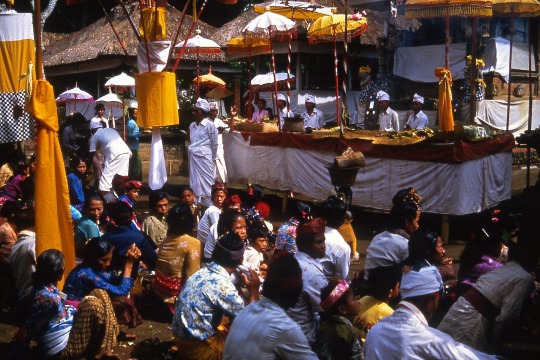 |
CULTURES IN CONTEXT Bali: Ancient and Modern 9. Festivals : 104-118 |

104. The Balinese calendar is based on the movement of the seven visible planets. A year is 210 days in length, and includes periods designated for particular festivities … comparable with the religious holidays established in Christian countries. In Bali the highlight of the year is the festival of Galungan, which lasts 10 days and involves almost everybody, even today. |
105. During this time spirits are believed to come down to earth to join in the festivities. Gods sit on decorated thrones in the temple. And the spirits of the village's ancestors reoccupy the homes of their descendants. |
106. It takes weeks to prepare for Galungan and everyone, young and old, male and female, has something to do. Men slaughter the animals and cook the meat. |
107. Men also decorate the streets with penjors, made from bamboo poles and palm leaves. |
108. They prepare beautiful banners, known as lamaks, outside each house. These are made from dark green sugar palm leaves and yellow-green young coconut palm leaves. |
109. They also build small shrines outside every house -- so the spirits of their ancestors have somewhere to rest. |
110. Women decorate their homes and gardens, and prepare elaborate food offerings. Some are destined for family shrines … others for village temples. Traditionally these offerings were made at home, but in the larger towns today, they are sometimes bought ready made. |
111. On the morning of the festival the streets are lined with women heading for the temple… with offerings on their heads. Everything is arranged beautifully so the gods will be pleased. |
112. The sashes people wear around their waists are a symbolic separation between good and evil. When praying they want to be free of unworthy thoughts which come from the earth below, so they can focus instead on the purer world above. |
113. The outer courtyard of the temple will have been used for cock-fighting the day before, and men will have placed bets on each fight. Gambling is permitted at festivals because the shedding of blood is (as in many religions) part of the process of purification ... and in Bali’s case a way to appease demon spirits. |
114. Razor-sharp metal spurs are attached to each cockerel and the birds are carefully groomed for their moment of glory. With long knives like these, fights do not last long. The winner lives to fight again: the loser is eaten |
115. When they reach the temple the women hand their offerings to the priest, who blesses each one … holding it up in front of the gods (like "wave offerings" in the Bible) before placing it on a table. |
116. The women then kneel in prayer, and throw flowers towards the shrines. |
117. The priest will sprinkle them with holy water, and his assistants will give them water to drink. |
118. Later the women collect their offerings. The gods, seemingly, will have by now consumed the essence, or spirit, of the food waived in front of them. Instead of wasting the substance that remains the women take it home for their family to eat … rather like a harvest festival. |
![]()
![]()
Text, photos and recordings
by John Tyman
Intended for Educational Use
Only.
Contact Dr. John Tyman at johntyman2@gmail.com
for information regarding public
or commercial use.
![]()
www.hillmanweb.com
Photo processing, Web page layout,
formatting and hosting by
William
Hillman ~ Brandon, Manitoba ~ Canada